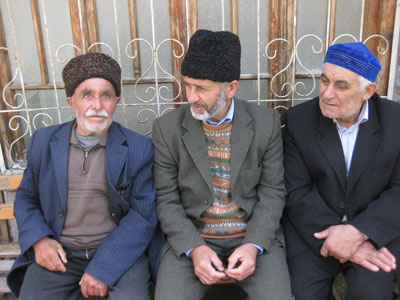Caucasus with MIR
I took an extraordinary tour, “Treasures of the Trans-Caucasus: Classic Survey of Azerbaijan, Georgia & Armenia,” with MIR Corp. (Seattle, WA; 800/424-7289), May 4-18, 2010. The trip cost $6,395, land, and visas for Armenia and Azerbaijan added $246. (US citizens do not need a visa to enter Georgia.)
Our 13-person group began the tour in Baku, Azerbaijan, on the Caspian coast. At the end of an important oil pipeline, Baku is the center of the Caspian oil industry. South of Baku, we visited the Gobustan Rock Art Cultural Landscape, where there are petroglyphs from 5,000 to 40,000 years old.
In Sheki we visited mosques, mausoleums and markets, listened to Azeri music as we dined in a caravanserai, and spoke with three Peace Corps volunteers working in Azerbaijan.
We traveled toward Georgia, one of the first countries to adopt the Christian faith (in the early fourth century). As we climbed higher into the snow-covered Caucasus Mountains, the stunning views became more dramatic.
In Gurjaani, we experienced traditional Georgian hospitality at a wine tasting, where the tamada (toastmaster) raised a glass to health, world peace and safe travels. Folk singers enhanced our enjoyment of an abundant feast.
In addition to showing us Tbilisi, the cave town Uplistsikhe, the Gudauri ski resort and Gori (Stalin’s hometown), MIR arranged a private concert at the home-turned-museum of Georgian artist Elene Akhvlediani (1898-1975).
Another highlight was the David Gareja monastery, considered the most remarkable of all of Georgia’s ancient sites. A highly revered figure in the country, Gareja was a sixth-century monk who spread the Word of Christianity.
Armenia was our next stop. This is a thriving, fascinating country of ancient monasteries and forts that contrast with its delightful modern capital, Yerevan, with its open-air cafés, numerous fountains and interesting museums. Yerevan is the cultural, economic and political heart of Armenia, and of the three capital cities we visited it was my favorite.
Although Mt. Ararat is in Turkey, it is visible from Yerevan and is an absolutely awesome sight.
A “must see” in Yerevan is the Armenian Genocide Memorial & Museum, commemorating the agony of the 1915-1922 genocide. The “eternal flame” monument is very moving.
In Ejmiatsin, Etchmiadzin Cathedral is the Holy See of the Armenian Orthodox Church, and among the relics on display there are, purportedly, a piece of Noah’s Ark and the spearhead that pierced Christ’s side on the cross.
MIR arranged for us to attend a private concert at the Temple of Garni, built to honor Helios, the Roman sun god. At fourth-century Geghard monastery, we saw the cave church and the many khachkars, stone slabs carved with crosses and other religious symbols.
An outing to Lake Sevan included stops at the fascinating monasteries Goshavank and Sevanavank. The view overlooking the lake was breathtaking, especially after climbing the many steps to the church at the top.
Gracious people and great food are some of the highlights I’ll remember from this gem of a tour. Hotels were first class. I was impressed by MIR’s knowledgeable local guides, and the MIR tour leader who was with us for the entire trip, Martin Klimenta, was absolutely outstanding. We were fortunate to have him. I’ll definitely consider MIR for future travels.
KATHRYN WHITMER
Bellingham, WA
CORRECTION (September '11 issue, pg. 50) — This letter previously stated incorrectly, regarding a site in Armenia, “In Ejmiatsin, Etchmiadzin Cathedral is the Holy See of the Georgian Orthodox Church.” Actually, it is the Holy See of the Armenian Apostolic Church. We thank our readers who pointed out this error.
To clarify, “Ejmiatsin” and “Etchmiadzin” are spelling variants of the same name, shared by both the town and the cathedral. — Editor

